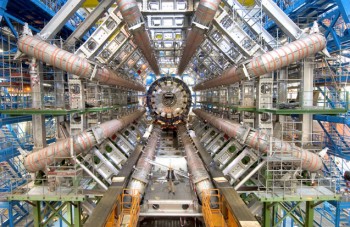What does particle physics have in common with paleoanthropology? A lot, actually.
I recently attended a public lecture on the Higgs boson by a theoretical astrophysicist named Dr. Lawrence Krauss at the Smithsonian National Museum of Natural History. Dr. Krauss’s talk was entitled, “The Higgs Boson Particle: Why it Matters.”
Get it? Matters?
Anyway, as I was sitting there, in the center of a crowd of 300+ people, I learned a lot of things. I learned that the search for the Higgs boson took several decades. I learned that such a search was expensive (and indeed difficult to sell to Congress). But most importantly, I learned what “humanity at its best” looks like.
Every second, Dr. Krauss said, the Large Hadron Collider in Geneva, Switzerland produces enough data to fill 1000 1-terabyte hard drives. Every. Second. This mega-machine is comprised of 40+ tons of steel that can collide two tiny particles moving at 99.99% the speed of light. Remarkable, isn’t it?
More fascinating than what the LHC can do, is what it took to build. The LHC is the product of over 10,000 scientists from all over the world, practicing different cultures, speaking different languages. And yet, after nearly two decades, these scientists were able to detect a particle that is 1/100th the size of a proton—the Higgs boson.
As a Paleolithic archaeologist, I spend a lot of time thinking about the earliest forms of technology—when our ancestors, at least 2.6 million years ago in eastern Africa, first picked up stone tools and used them to alter their environment.
Fast forward a couple million years to the Middle Stone Age of Africa, between about 500 to 50 thousand years ago, when humans very similar to us began to make tools not only for survival, but with symbolic meaning.
How, then, did these tools come about? Did early humans also need to collaborate across language barriers, as modern scientists did in creating the LHC? Did local economics play a role, and if so, to what extent? What drives innovation, and what circumstances enable an innovation to be sustained?
Dr. Krauss ended his lecture with an interesting thought: the Large Hadron Collider is like a 13th Century Gothic cathedral. Its creation stretched financial resources to the limits, tested the boundaries of known technology, and required generations of scientists to build. And yet young students like me can still marvel at its grandeur, a testament to what humanity can accomplish.
As I wrestle with the above questions in my own dissertation research, wondering how we got from pounding tools to particle colliders, I see many parallels between physics and paleoanthropology.
Our questions may take decades to answer. They may cost wads of money. And they will no doubt involve increasingly larger teams of researchers to solve.
But most of all, studying human evolution is exciting. New methods in ancient DNA, geometric morphometrics, and paleoecology—just to name a few—are uncovering more pieces of the archaeological record every day. Like the physicists on the cusp of discovering the Higgs boson just last year, paleoanthropologists too are at the edge of knowledge.
Not only am I excited about the future of paleoanthropological research and the results we will see in our lifetime, I am excited to be a part of it—to lay some stones in the cathedral of knowledge.
References
Krauss, L. 2013. “The Higgs Boson Particle: Why it Matters.” Smithsonian National Museum of Natural History. Baird Auditorium, Washington, DC. 14 Jan.
Wilkins, J., et al. 2012. Evidence for early hafted hunting technology. Science 338: 6109 942-946.


